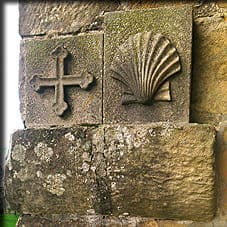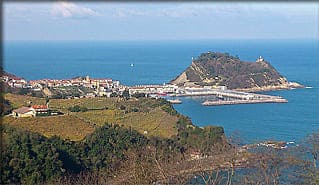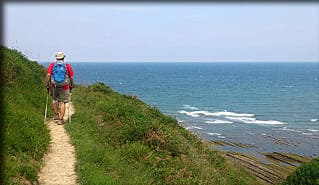


This route covers the first stages of the Northern or Coastal Way along the impressive Basque coast and runs through the same places that have been travelled by pilgrims for centuries. In fact, you can still walk on some stretches of the old medieval path they used. This is one of the oldest routes since it was the most used when most of the Iberian Peninsula was occupied by the Moors.
The way is full of vestiges that tell us that we are walking towards Santiago de Compostela: hermitages decorated with pilgrims’ shells, crosses and all kinds of signs come out to meet us every step of the way. The route is very well marked with abundant yellow arrows, making it easy to follow.

It begins in the lovely city of Hondarribia, next to the French border, arrives in San Sebastian (for many the most beautiful city in Spain) and crosses the charming fishing villages of the coast, until arriving at the historic town of Gernika. The last night can be spent in Bilbao, where you can visit the Guggenheim Museum, or return to San Sebastian.
All along the way you will be able to enjoy the world-renowned Basque cuisine and its famous pintxos, staying in a range of quality accommodations, all of them with a lot of charm.

This trip along the Pilgrim's Way to Santiago is not only very interesting because of its attractive stages on foot, but also because of the accommodations in which our clients stay. Indeed, the fact that we are a local travel agency has allowed us to select the hotels directly and, being located in San Sebastian, we have been able to choose them and frequently visit them in person.
The lodgings that we use on our Camino a Santiago along the coast route are very different from each other, which adds a special interest to the arrival of each stage. This variety is one of the attractions that our clients highlight. Although each one has its own style, all of them have a high level of quality and lots of charm and, of course, we have avoided the typical large and impersonal hotels, as well as the basic and crowded pilgrim hostels. On our Pilgrim's Way to Santiago you will stay in an old charming house in the historic centre of a medieval village, as well as in a modern and comfortable accommodation 100 metres from the world famous beach of La Concha in San Sebastian. In a beautiful Bed & Breakfast personally decorated by its owner who has a keen interest in antiques or in the rooms of an impressive gothic medieval tower of the 15th century located in the centre of a beautiful fishing village. In an idyllic hotel with a swimming pool in front of the Cantabrian Sea, or in a Basque farmhouse dating from the 17th century where you can visit its fantastic orchard.
All rooms have complete en-suite bathrooms. In all these accommodations you will also be able to enjoy a good breakfast and you will be given a picnic lunch. You are sure to have a comfortable rest and recover your strength for the next stage, getting to know and enjoying the different types of fantastic accommodation that the Camino de Santiago offers as it passes through the Basque Country.
So, as we Basques say in our ancient language, Euskera, "Gabon eta atseden har dezazula" (Good night and have a good rest!).
The Way of St. James along the coast can be done at any time of the year. In fact, it is common to see pilgrims walking along this beautiful itinerary towards Santiago de Compostela in any month. Besides, you can arrive and start the route the day of the week you prefer.
PRICES
Prices are per person and based on two people sharing a twin or double room.
Included:
(*) Possibility of organizing additional nights of accommodation along the route to have rest days and more time to visit some interesting cities and places. Please check with us if you are interested.
Not included:
(**) Possibility to order private transfers from/to Biarritz or Bilbao, at an additional charge.
How can I get to the area?
Today, the Basque Country is a highly developed area that has very good communications by land, sea and air making it easy to get here. There are several options to fly to our different airports and our cities are connected by modern motorways. You also have the option of coming by bus, train and even by boat if you come from Great Britain. For more information, see the "How to get here" section of the "Information" tab.
What currency and language is used in the area?
As in the other countries of the European Union, the currency used is the euro. With regard to languages, this is one of the many attractions of this region because, apart from Spanish, one of the oldest and most mysterious languages in the world is spoken in the Basque Country: Basque. While you are here, you will often hear and see Basque and we will tell you some curious facts about this ancient language. With regard to English, the Basque coast is a very touristic area and, as such, it is increasingly easier to communicate in this language.
Is it a very crowded route?
Although it is quite possible that you will find other pilgrims along the route, the Camino de Santiago along the coast is by no means crowded. Currently, only 4% of the pilgrims follow this itinerary, while around 80% walk along the saturated French Way. That is why, on many occasions, you will walk in solitude, enjoying the silence and the landscape.
Is it easy to find your way around or follow the route?
Yes, every Way to St. James is very well signposted with yellow arrows and wooden posts. The Northern route is no exception and it is very easy to follow the right route. Also, remember that we will provide you with detailed information in our route cards.
Is it a safe route?
Yes, fortunately, this area is very safe and pilgrims do not usually have any problems on their way. Therefore, it is not difficult to find people who are hiking the route alone. Also, remember that our agency is located in San Sebastian and that you can contact us at any time, either through the accommodation where you are staying, or directly to the contact telephone number that we will give you on your arrival.
Can I book a one-person trip?
Although it is ideal to be able to share the experiences of the Pilgrim's Way to Santiago with other people, it is possible to book this trip for individuals, at an additional charge (please consult prices in the Dates/Prices tab).
What is the best time of year to make this trip?
Probably, the best months to travel the Camino de Santiago are May, June, September and October although, because the route runs by the sea, temperatures are usually very mild and the itinerary can be walked at any time of the year. As it is a tourist area, there are usually many foreign visitors from mid-July to mid-September.
Is it possible to shorten some stages?
Yes, if you don't want to walk all or part of any of the stages, you can shorten them by hiring a private taxi service, which you should pay directly to the driver. This taxi can be hired the day before, either directly in the accommodation where you are or by contacting us.
Which cities are worth spending more time in?
San Sebastian is probably the most beautiful city in Spain and certainly worth staying more than a day. Bilbao is also very interesting, especially due to the presence of the Guggenheim Museum in the city centre. Hondarribia and Getaria are beautiful fishing villages with old buildings, streets and squares reminiscent of their medieval past.
I have some kind of dietary restriction, is it possible to take this into account?
Of course, although one of the main attractions of the Basque Country is its gastronomy, every year we welcome people who have some kind of dietary restriction. In these cases, we inform all the accommodations and restaurants we work with so that this is taken into account.
If you have any other questions, please click here and send us an e-mail with your questions. Thank you very much.
We use cookies to ensure that we give the user the best experience on our website. If you continue to use this site we assume that you agree with our cookie policy. Privacy and Cookie policy Ok.